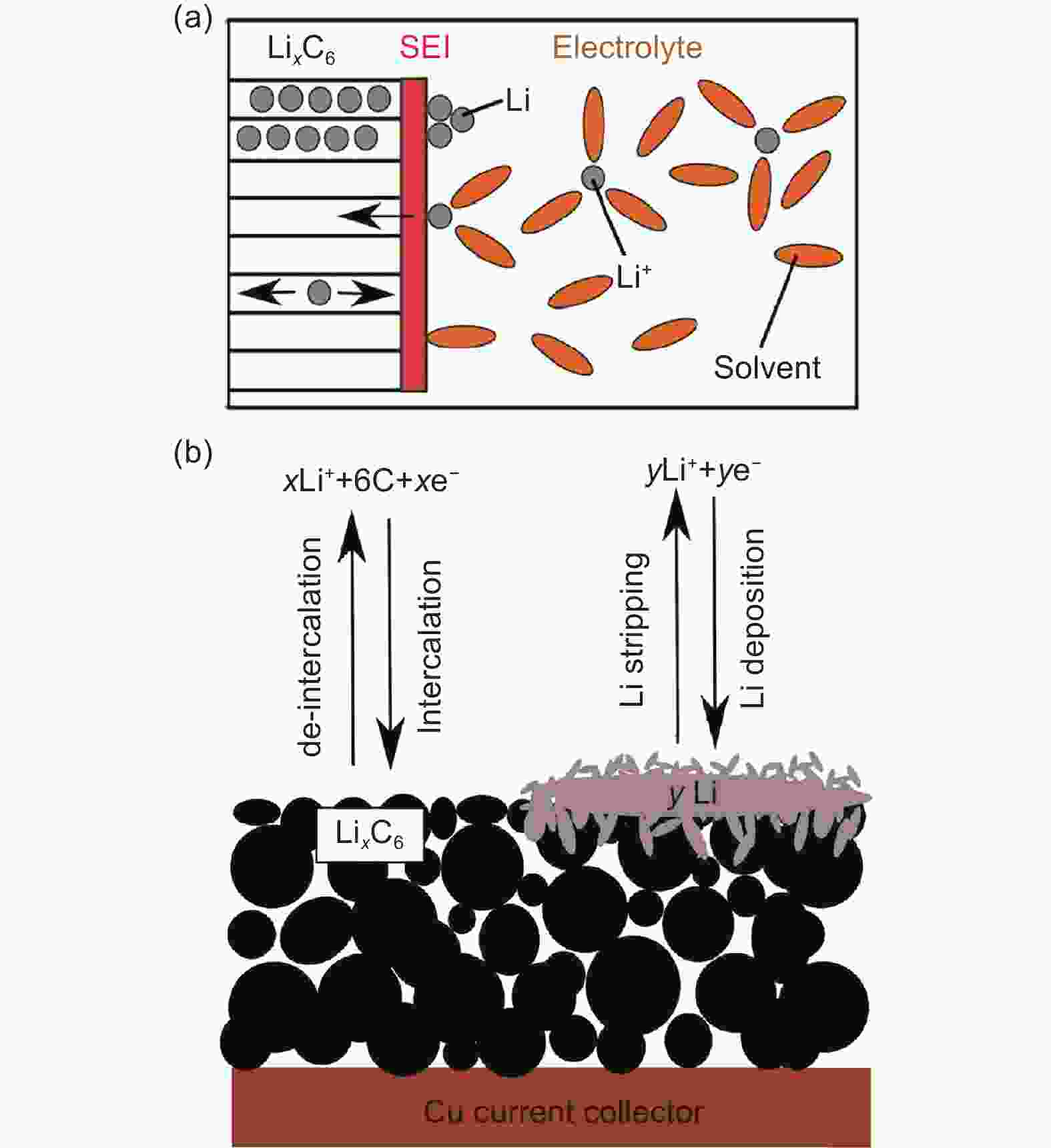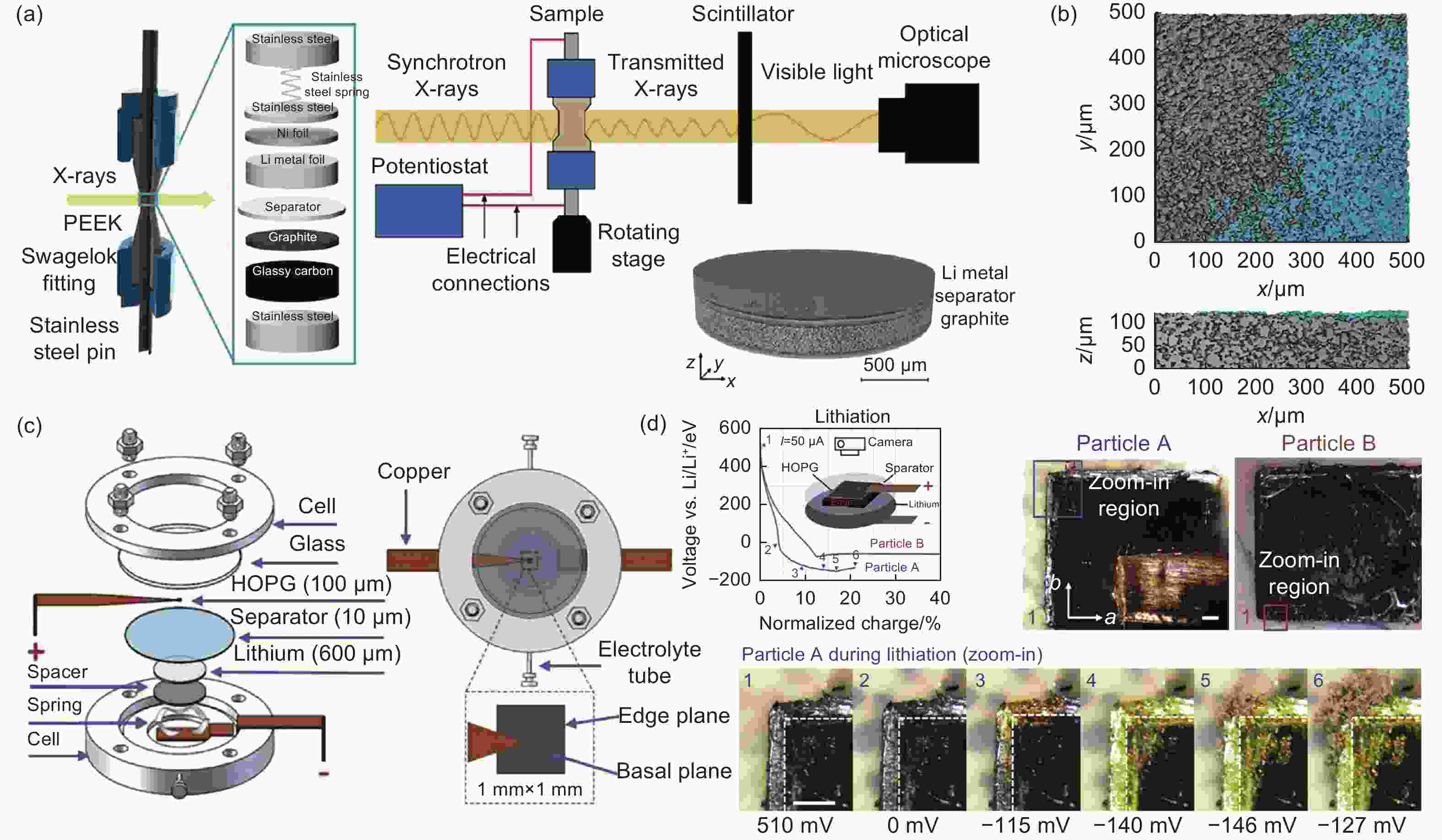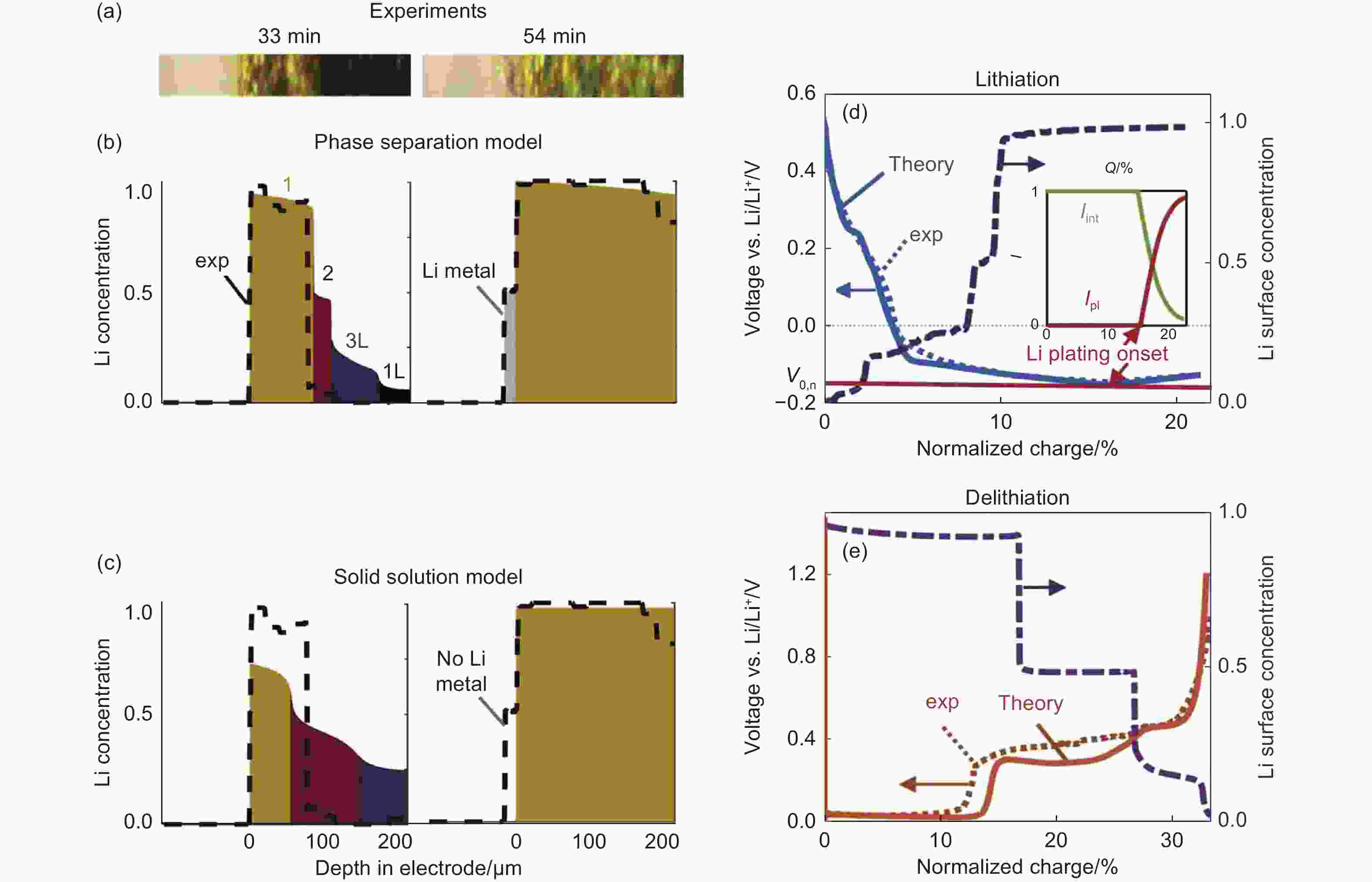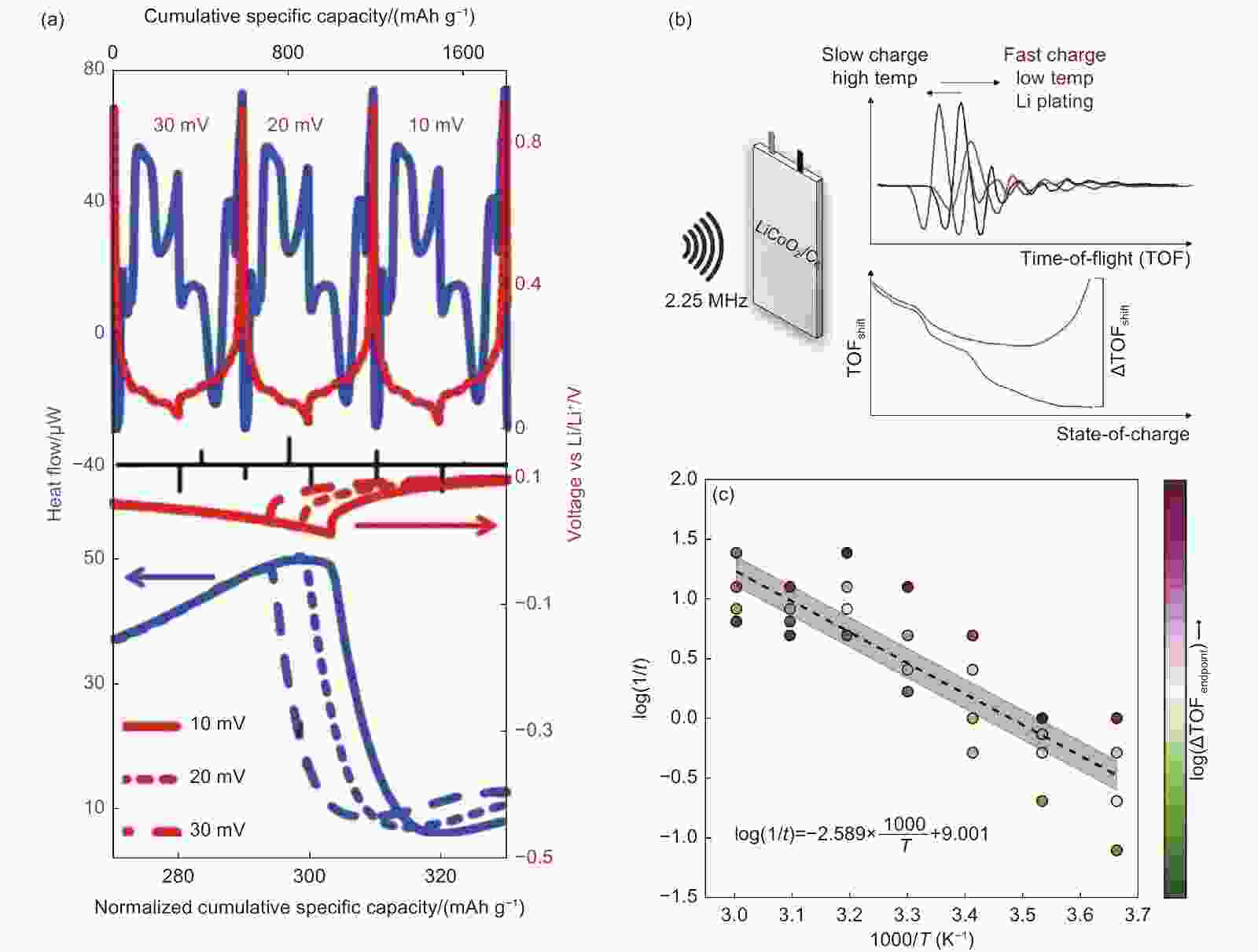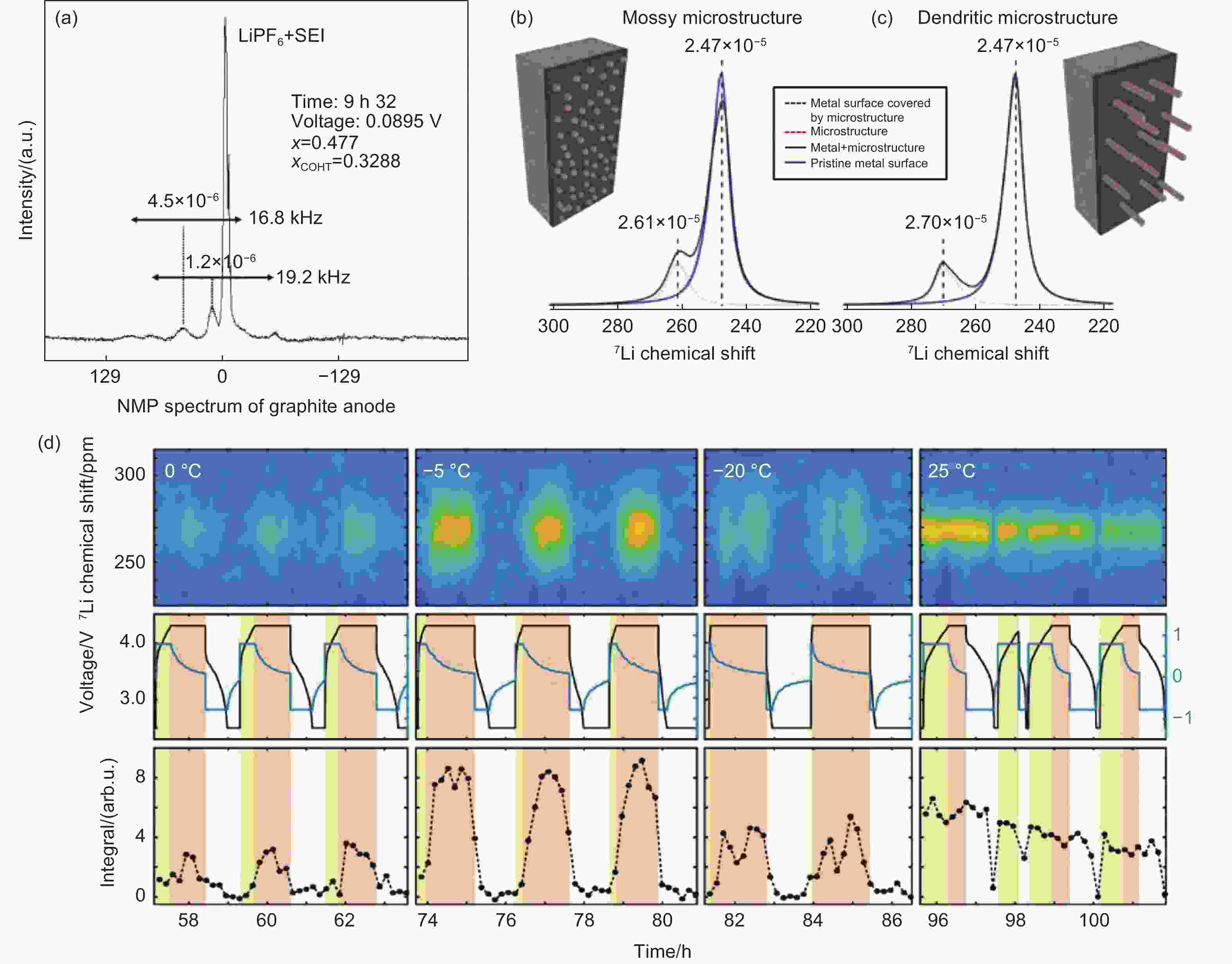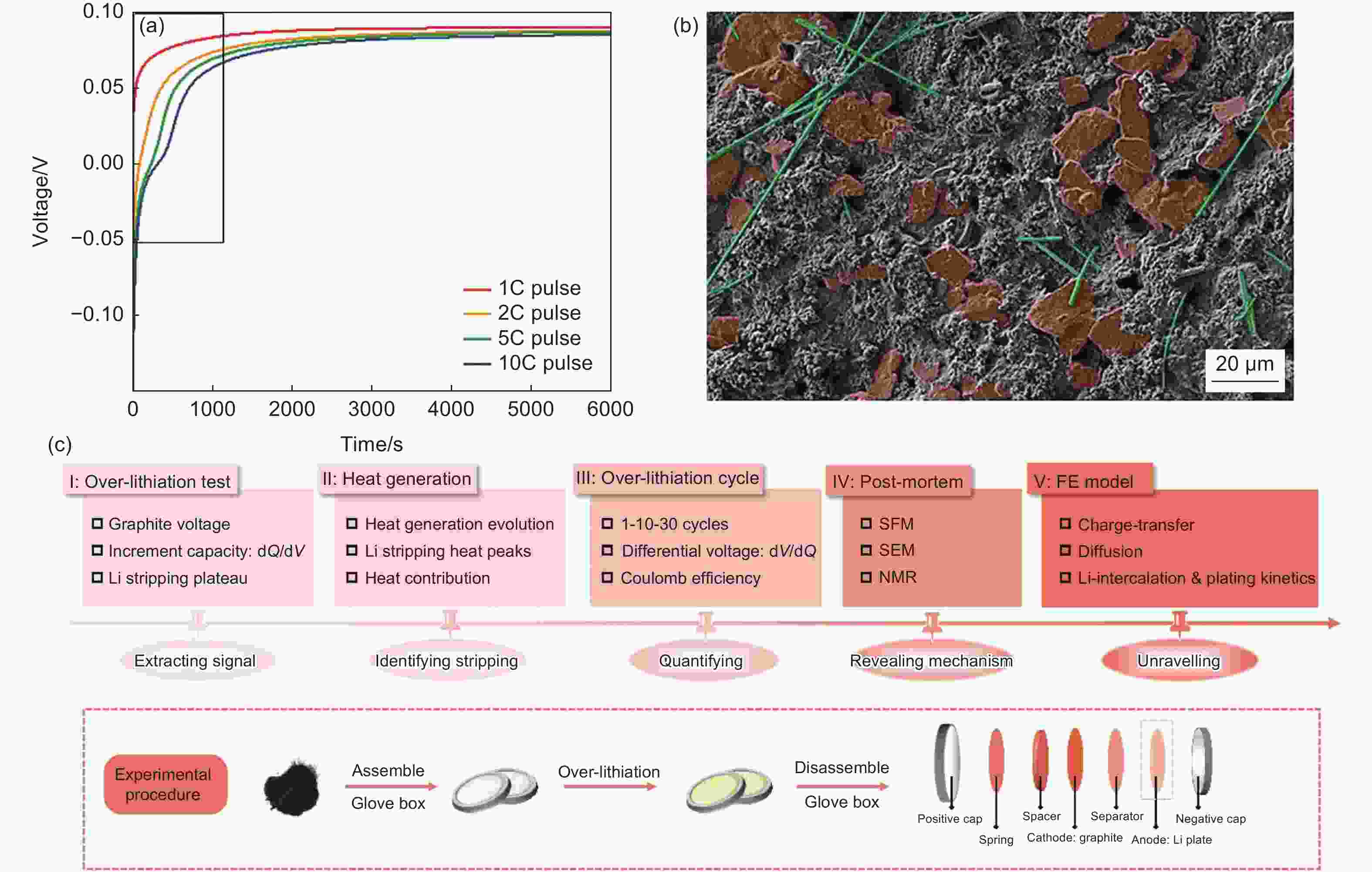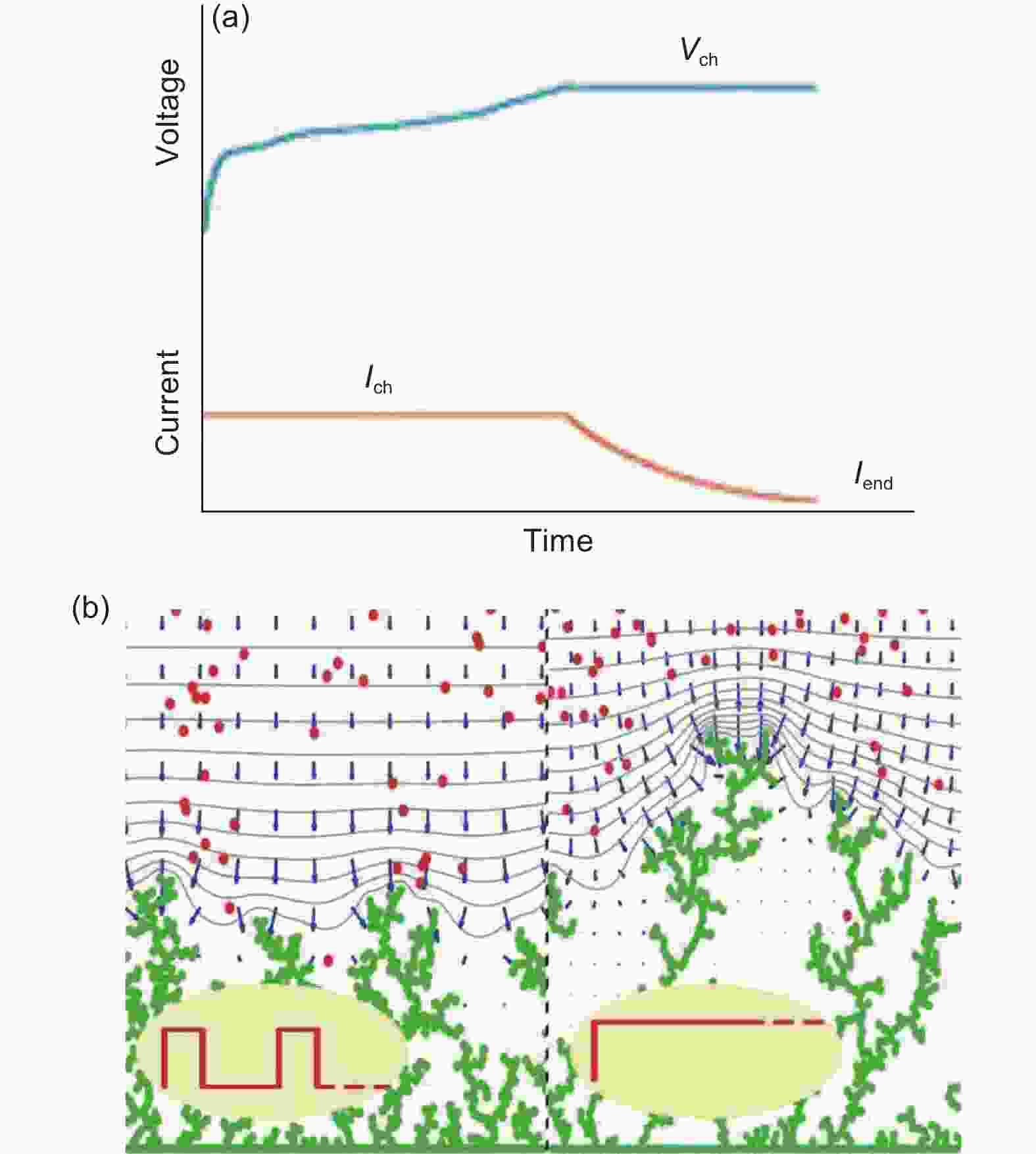Understanding the process of lithium deposition on a graphite anode for better lithium-ion batteries
-
摘要: 全面推进交通运输电气化是实现“碳中和”的根本途径,而以电化学能量储存和转化为核心的电池、电容器等储能技术的开发是其中的重要环节。锂离子电池具有储能密度高、充放电效率高、响应速度快、产业链完整等优点,是最近几年发展最快的电化学储能技术。石墨具有导电性好、成本低、循环寿命长、溶胀率低、安全性高等优点,是锂离子电池负极的首选材料。然而石墨负极金属锂的沉积不仅降低电池循环及快充性能,而且带来电池短路甚至爆炸等安全隐患。本综述概述了石墨负极的电化学动力学过程,总结了依托原位技术对锂沉积机理的解析,讨论了锂沉积过程的影响因素以及解决办法。最后提出了本领域今后发展过程中可能面临的挑战及机遇。Abstract: A brief overview of recent developments in the formation, detection, and suppression of lithium dendrites in carbon-based lithium-ion batteries is presented. The electrochemical processes that result in the formation of lithium dendrites on the anode surface are reviewed, and various detection methods, including the essential operando technique for understanding the complex mechanism, are then introduced. Methods for suppressing lithium dendrite formation are discussed and prospects for future research and development are presented.
-
Key words:
- Graphite anode /
- Lithium deposition /
- Lithium-ion batteries /
- Mechanism /
- In situ detection
-
Figure 1. (a) Mechanism for the SEI formation. (b) Possible electrochemical processes occurred on graphite anode under the microscopic level[16]. Reproduced with permission. Copyright 2018, Elsevier B.V.
Figure 2. (a) Cell voltage, cathode potential, and anode potential vs. charging time of a mesophase carbon micro beads (MCMB)/LiCoO2 lithium-ion cell in typical CC/CV charging profiles[34]. Reproduced with permission. Copyright 2006, Elsevier B.V. (b) Differential capacity curves of the discharge profiles after charging to different SOC levels at −20 °C with 1 C charge current[35]. Reproduced with permission. Copyright 2013, Elsevier B.V. (c) Differential OCVs extracted from cycling data in cycles begin with fully delithiated graphite (x < 0.01 in LixC6), which is ensured by slow C/5 discharging up to 1.5 V. After 4 C charging to 25%–40% SOC, the dQ/dV profiles show an inflection point feature not observed at 15%–20% SOC, suggesting plating begins near 25% SOC[36]. Reproduced with permission. Copyright 2020, American Chemical Society
Figure 3. (a) Schematics of the X-ray microtomography setup and cell configuration. (b) Volume rendering of the NW portion of the segmented graphite electrode in the xy-plane and xz-plane after discharge to 100% SOC at 1C. The gray indicates the graphite and the mossy lithium is shown in turquoise[37]. Reproduced with permission. Copyright 2021, American Chemical Society. (c) Schematic of the optical electrochemical in-situ cell. (d) Voltage profile and optical images of the HOPG under various potentials[40]. Reproduced with permission. Copyright 2021, Elsevier Inc
Figure 4. (a) Examples of graphite particles images used to extract the lithium concentration and lithium plating profiles. (b) The phase separation model and the solid-solution model used to understand the lithium deposition processed. Voltage and the corresponding lithium surface concentration during (d) lithiation and (e) de-lithiation of graphite[40]. Reproduced with permission. Copyright 2021, Elsevier Inc
Figure 5. (a) Thermal (blue) and voltage (red) profiles of a MCMB graphite/lithium half cell cycled at C/10 to varying cutoff voltages[41]. Reproduced with permission. Copyright 2013, The Electrochemical Society. (b) Linear relationships between ultrasonic time-of-flight (TOF) and graphite staging. (c) The relationship between the logarithmic rate (1/t) and the inverse temperature (1000/T), the color bar is used to factor in the TOF endpoint difference between the C/15 charge and the fixed capacity charge[43]. Reproduced with permission. Copyright 2020, Cell Press
Figure 6. (a) Fitting profiles of scattering length density (SLD) under different lithium layers. (b) Dependences of the mean thickness and roughness of the deposited layer (SEI + lithium) on the lithium layer thickness calculated from electrochemical data[44]. Copyright 2017, Elsevier B.V. (c) The diffraction data of the graphite anode under different conditions, which was charged at C/5 or C/30 charge (left) and after a 20 h relaxation period at −20 °C (right). (d) Changes of integral reflection intensity of LiC12 (red, orange), LiC6 (blue, cyan) and Li1−xC18 (black, gray) during 20 h relaxation at −20 °C under C/30 and C/5 charge[45]. Reproduced with permission. Copyright 2014, Elsevier B.V.
Figure 7. (a) NMR spectrum of graphite anode during the first discharge[46]. Reproduced with permission. Copyright 2007, Elsevier Ltd. Simulated spectra from the FFT susceptibility calculation results for a lithium electrode with (b) a mossy type microstructure and (c) dendritic microstructure covering the surface[48]. Reproduced with permission. Copyright 2015, American Chemical Society. (d) Summary of the operando NMR results of NMC811/graphite full-cells operated at different temperatures: the lithium metal spectra at top panels, the corresponding voltage (black) and current (blue) profiles in middle and the lithium metal signal integral at bottom[49]. Reproduced with permission. Copyright 2020, American Chemical Society
Figure 8. (a) Selected EPR spectra, with spectra shown with an x-axis offset. (b) Potential curves of lithium intercalation at −20 °C at different C-rates. (c) Amount of metallic lithium as determined from operando EPR spectra as a function of intercalation capacity and applied C-rate[52]. Reproduced with permission. Copyright 2018, Elsevier Ltd. (d) The EPR intensity of metallic Li0 deposition at graphite anode during the first two cycles with VC (blue) and without VC additive (black) at 0.1 mV s−1 and without VC at a lower scan rate of 0.04 mV s−1; (e) Li0 formation on the graphite surface during cycling from 0.05 to 1 V at 2 mV s−1[53]. Reproduced with permission. Copyright 2021, Wiley-VCH GmbH
Figure 9. (a) Measured voltage transients during the relaxation of the cell voltage after charging pulses with different current amplitudes. (b) SEM of the graphite anode cycled at C/5 for 5 times from 0.01 to 0.5 V. Graphite particles are marked red, the fibers (marked green) are separator remnants[54]. Reproduced with permission. Copyright 2015, Elsevier B.V. (c) Schematic diagram illustrating experimental and model approaches in understanding lithium plating synopsis[55]. Reproduced with permission. Copyright 2021, Elsevier B.V.
Figure 10. (a) Schematic representation of (i) lithium metal nucleation on the graphite surface during high current charging and (ii) reduced nucleation due to increased overpotential for lithium metal deposition afforded by a Cu or Ni surface coating with a structural mismatch[58]. Reproduced with permission. Copyright 2019, American Chemical Society. (b) The impedance of natural graphite and ball-milling graphite after the first cycle and 20 cycles[59]. Reproduced with permission. Copyright 2019, Elsevier Ltd. (c) CE and discharge capacity of G, dCNT-G, and dCNT-G/G for 300 cycles (0.3 C)[60]. Reproduced with permission. Copyright 2022, Royal Society of Chemistry
Figure 11. (a) The first charge-discharge curves of the LFP electrodes harvested from the cycled cells with different capacity losses[63]. Reproduced with permission. Copyright 2015, Elsevier Ltd. TEM images of the graphite electrode charged to 0.1 V after 5 cycles of lithium plating/stripping in the (b) LiFSI and (c) LiPF6 electrolyte[65]. Reproduced with permission. Copyright 2021, American Chemical Society. Conceptual illustrations of (d) liquid electrolyte which contains highly solvated lithium and ion-solvent clusters and (e) the GOQD-decorated polymer chains in GPE-PAVM: QD immobilize PF6− to minimize both the ion-solvent clusters and degree of lithium ion solvation, resulting formation of space-charge layers that facilitate the transport of lithium ions.[62]. Reproduced with permission. Copyright 2018, Wiley-VCH GmbH
Figure 12. (a) The voltage and the current plots under the CC/CV mode[72]. Reproduced with permission. Copyright 2016, Elsevier Ltd. (b) Simulations for charging with tON = 1 ms (left) and tON = 20 ms (right) at γ = tOFF/tON = 3. Green dots: Li0. Red dots: Li. Gray lines: equipotential contours. Blue vectors: the electric field[71]. Reproduced with permission. Copyright 2014, American Chemical Society
Table 1. Anode modification methods of suppressing lithium plating
Anode modification Material/Method Advantages Refs. Anode coating layer β-PVDF coating (a) Mitigate lithium dendrite formation
(b) Maintain good cycling stability with 20% over-lithiation at 0.2 C[56] Carbon coated porous titanium
niobium oxides(a) Suppress lithium plating problem effectively under extreme fast charge condition
(b) Deliver a high energy(142.8 Wh kg−1) and a good energy retention[57] DC magnetron sputtering of nanoscale
layers of Cu and Ni(a) Increase the overpotential for lithium deposition
(b) Reduce the quantity of the plated lithium metal by ~50% compared to untreated electrodes[58] Anode structure modification Ball milling (a) Decrease the stress and strain upon co-intercalation of the solvated lithium ions
(b) Integrate the structure and enhance the lithium plating/stripping cyclability of the graphite[59] Defective carbon-nanotube-
grown graphite(a) Result in densely packed lithium deposition without any dendritic lithium plating
(b) Remain electrochemically active even after 300 cycles[60] Table 2. Advantages and disadvantages of charging protocols
Charging protocols Method Advantages Disadvantages Effect on lithium plating Refs. Constant current
constant voltage (CC/CV)Step1: CC-1
Step2: CC-2
Step3: CV-1Simple, easy implementation,
superior cycle life
(over 5000 cycles)Poor rate capacity,
uncontrollable temperatureDetermined by
constant current
and voltage[68, 69] Multi-stage constant
current (MSCC/CV)Step1: Multistage CC
Step2: Multistage CC/CV
Step3: Multistage CC
Step4: CVShort charging time, optimum
battery performance, and
thermal managementSOC needs to be estimated
precisely, hard implementationLimited effects [68, 70] Pulse charging Nonlinearly decrease of charge
current with the evolution of
mass transfer coefficientReduced charging time,
low polarizationDifficult to choose proper
parameters for pulse sequence,
easy to cause electrodes pulverizationSuspension of charge
can inhibit
lithium plating[68, 71] Boost charging High pulse currents
followed by CC/CVEasy implementation,
no impact on cycle lifeUncontrollable temperature,
unoptimized charging rate- [68] -
[1] Zhu Y L, Wang Y X, Gao C, et al. CoMoO4-N-doped carbon hybrid nanoparticles loaded on a petroleum asphalt-based porous carbon for lithium storage[J]. New Carbon Materials,2020,35(4):358-370. doi: 10.1016/S1872-5805(20)60494-2 [2] Wu M B, Li L Y, Liu J, et al. Template-free preparation of mesoporous carbon from rice husks for use in supercapacitors[J]. New Carbon Materials,2015,30(5):471-475. doi: 10.1016/S1872-5805(15)60201-3 [3] Xia L, Yu L, Hu D, et al. Electrolytes for electrochemical energy storage[J]. Materials Chemistry Frontiers,2017,1(4):584-618. doi: 10.1039/C6QM00169F [4] Guan L, Hu H, Teng X L, et al. Templating synthesis of porous carbons for energy-related applications: A review[J]. New Carbon Materials,2022,37(1):25-45. doi: 10.1016/S1872-5805(22)60574-2 [5] Moharana S, West G, Walker M, et al. Controlling Li dendritic growth in graphite anodes by potassium electrolyte additives for Li-ion batteries[J]. ACS Applied Materials & Interfaces,2022,14(37):42078-42092. [6] Armand M, Tarascon J M. Building better batteries[J]. Nature,2008,451(7179):652-657. doi: 10.1038/451652a [7] Goodenough J B, Park K S. The Li-ion rechargeable battery: A perspective[J]. Journal of the American Chemical Society,2013,135(4):1167-1176. doi: 10.1021/ja3091438 [8] Etacheri V, Marom R, Elazari R, et al. Challenges in the development of advanced Li-ion batteries: a review[J]. Energy & Environmental Science,2011,4(9):3243-3262. [9] Palacín M R, de Guibert A. Why do batteries fail [J]? Science, 2016, 351(6273): 1253292. [10] Wang X, Huang R Q, Niu S Z, et al. Research progress on graphene-based materials for high-performance lithium-metal batteries[J]. New Carbon Materials,2021,36(4):711-728. doi: 10.1016/S1872-5805(21)60081-1 [11] Fang R, Chen K, Yin L, et al. The regulating role of carbon nanotubes and graphene in lithium-Ion and lithium–sulfur batteries[J]. Advanced Materials,2019,31(9):1800863. doi: 10.1002/adma.201800863 [12] Wakihara M. Recent developments in lithium ion batteries[J]. Materials Science and Engineering:R:Reports,2001,33(4):109-134. doi: 10.1016/S0927-796X(01)00030-4 [13] Ecker M, Shafiei Sabet P, Sauer D U. Influence of operational condition on lithium plating for commercial lithium-ion batteries[J]. Electrochemical experiments and post-mortem-analysis. Applied Energy,2017,206:934-946. [14] Cai W, Yan C, Yao Y X, et al. The boundary of lithium plating in graphite electrode for safe lithium-Ion batteries[J]. Angewandte Chemie International Edition,2021,60(23):13007-13012. doi: 10.1002/anie.202102593 [15] Lu J, Chen Z, Pan F, et al. High-performance anode materials for rechargeable lithium-ion batteries[J]. Electrochemical Energy Reviews,2018,1(1):35-53. doi: 10.1007/s41918-018-0001-4 [16] Waldmann T, Hogg B I, Wohlfahrt-Mehrens M. Li plating as unwanted side reaction in commercial Li-ion cells- a review[J]. Journal of Power Sources,2018,384:107-124. doi: 10.1016/j.jpowsour.2018.02.063 [17] Liu Q, Du C, Shen B, et al. Understanding undesirable anode lithium plating issues in lithium-ion batteries[J]. RSC Advances,2016,6(91):88683-88700. doi: 10.1039/C6RA19482F [18] Li Z, Huang J, Yann Liaw B, et al. A review of lithium deposition in lithium-ion and lithium metal secondary batteries[J]. Journal of Power Sources,2014,254:168-182. doi: 10.1016/j.jpowsour.2013.12.099 [19] Aurbach D, Zinigrad E, Cohen Y, et al. A short review of failure mechanisms of lithium metal and lithiated graphite anodes in liquid electrolyte solutions[J]. Solid State Ionics,2002,148(3):405-416. [20] Persson K, Sethuraman V A, Hardwick L J, et al. Lithium diffusion in graphitic carbon[J]. The Journal of Physical Chemistry Letters,2010,1(8):1176-1180. doi: 10.1021/jz100188d [21] Legrand N, Knosp B, Desprez P, et al. Physical characterization of the charging process of a Li-ion battery and prediction of Li plating by electrochemical modelling[J]. Journal of Power Sources,2014,245:208-216. doi: 10.1016/j.jpowsour.2013.06.130 [22] Purushothaman B K, Landau U. Rapid charging of lithium-ion batteries using pulsed currents: A theoretical analysis[J]. Journal of The Electrochemical Society,2006,153(3):A533. doi: 10.1149/1.2161580 [23] Arora P, Doyle M, White R E. Mathematical modeling of the lithium deposition overcharge reaction in lithium-Ion batteries using carbon-based negative electrodes[J]. Journal of The Electrochemical Society,1999,146(10):3543. doi: 10.1149/1.1392512 [24] Tang M, Albertus P, Newman J. Two-dimensional modeling of lithium deposition during cell charging[J]. Journal of The Electrochemical Society,2009,156(5):A390. doi: 10.1149/1.3095513 [25] Perkins R D, Randall A V, Zhang X, et al. Controls oriented reduced order modeling of lithium deposition on overcharge[J]. Journal of Power Sources,2012,209:318-325. doi: 10.1016/j.jpowsour.2012.03.003 [26] Hein S, Latz A. Influence of local lithium metal deposition in 3D microstructures on local and global behavior of lithium-ion batteries[J]. Electrochimica Acta,2016,201:354-365. doi: 10.1016/j.electacta.2016.01.220 [27] Waldmann T, Kasper M, Wohlfahrt-Mehrens M. Optimization of charging strategy by prevention of lithium deposition on anodes in high-energy lithium-ion batteries[J]. Electrochemical Experiments. Electrochimica Acta,2015,178:525-532. doi: 10.1016/j.electacta.2015.08.056 [28] Liu S, Xiong L, He C. Long cycle life lithium ion battery with lithium nickel cobalt manganese oxide (NCM) cathode[J]. Journal of Power Sources,2014,261:285-291. doi: 10.1016/j.jpowsour.2014.03.083 [29] Waldmann T, Hogg B-I, Kasper M, et al. Interplay of operational parameters on lithium deposition in lithium-ion cells: systematic measurements with reconstructed 3-electrode pouch full cells[J]. Journal of The Electrochemical Society,2016,163(7):A1232. doi: 10.1149/2.0591607jes [30] Bugga R V, Smart M C. Lithium plating behavior in lithium-ion cells[J]. ECS Transactions,2010,25(36):241. doi: 10.1149/1.3393860 [31] Waldmann T, Wilka M, Kasper M, et al. Temperature dependent ageing mechanisms in lithium-ion batteries: A post-mortem study[J]. Journal of Power Sources,2014,262:129-135. doi: 10.1016/j.jpowsour.2014.03.112 [32] Blyr A, Sigala C, Amatucci G, et al. Self-discharge of LiMn2O4/C Li‐ion cells in their discharged state: understanding by means of three‐electrode measurements[J]. Journal of The Electrochemical Society,1998,145(1):194. doi: 10.1149/1.1838235 [33] Lin H P, Chua D, Salomon M, et al. Low-temperature behavior of Li-ion cells[J]. Electrochemical and Solid-State Letters,2001,4(6):A71. doi: 10.1149/1.1368736 [34] Zhang S S, Xu K, Jow T R. Study of the charging process of a LiCoO2-based Li-ion battery[J]. Journal of Power Sources,2006,160(2):1349-1354. doi: 10.1016/j.jpowsour.2006.02.087 [35] Petzl M, Danzer M A. Nondestructive detection, characterization, and quantification of lithium plating in commercial lithium-ion batteries[J]. Journal of Power Sources,2014,254:80-87. doi: 10.1016/j.jpowsour.2013.12.060 [36] Konz Z M, McShane E J, McCloskey B D. Detecting the onset of lithium plating and monitoring fast charging performance with voltage relaxation[J]. ACS Energy Letters,2020,5(6):1750-1757. doi: 10.1021/acsenergylett.0c00831 [37] Ho A S, Parkinson D Y, Finegan D P, et al. 3D detection of lithiation and lithium plating in graphite anodes during fast charging[J]. ACS Nano,2021,15(6):10480-10487. doi: 10.1021/acsnano.1c02942 [38] Harris S J, Timmons A, Baker D R, et al. Direct in situ measurements of Li transport in Li-ion battery negative electrodes[J]. Chemical Physics Letters,2010,485(4):265-274. [39] Dahn J R. Phase diagram of LixC6[J]. Physical Review B,1991,44(17):9170-9177. doi: 10.1103/PhysRevB.44.9170 [40] Gao T, Han Y, Fraggedakis D, et al. Interplay of lithium intercalation and plating on a single graphite particle[J]. Joule,2021,5(2):393-414. doi: 10.1016/j.joule.2020.12.020 [41] Downie L E, Krause L J, Burns J C, et al. In situ detection of lithium plating on graphite electrodes by electrochemical calorimetry[J]. Journal of The Electrochemical Society,2013,160(4):A588. doi: 10.1149/2.049304jes [42] Birkenmaier C, Bitzer B, Harzheim M, et al. Lithium plating on graphite negative electrodes: Innovative qualitative and quantitative investigation methods[J]. Journal of The Electrochemical Society,2015,162(14):A2646. doi: 10.1149/2.0451514jes [43] Bommier C, Chang W, Lu Y, et al. In operando acoustic detection of lithium metal plating in commercial LiCoO2/graphite pouch cells[J]. Cell Reports Physical Science,2020,1(4):100035. doi: 10.1016/j.xcrp.2020.100035 [44] Avdeev M V, Rulev A A, Bodnarchuk V I, et al. Monitoring of lithium plating by neutron reflectometry[J]. Applied Surface Science,2017,424:378-382. doi: 10.1016/j.apsusc.2017.01.290 [45] Veronika Z, Christian V L, Michael H, et al. Lithium plating in lithium-ion batteries at sub-ambient temperatures investigated by in situ neutron diffraction[J]. Journal of Power Sources,2014,271:152-159. doi: 10.1016/j.jpowsour.2014.07.168 [46] Letellier M, Chevallier F, Morcrette M. In situ 7Li nuclear magnetic resonance observation of the electrochemical intercalation of lithium in graphite; 1st cycle[J]. Carbon,2007,45(5):1025-1034. doi: 10.1016/j.carbon.2006.12.018 [47] Börner M, Friesen A, Grützke M, et al. Correlation of aging and thermal stability of commercial 18650-type lithium ion batteries[J]. Journal of Power Sources,2017,342:382-392. doi: 10.1016/j.jpowsour.2016.12.041 [48] Chang H J, Trease N M, Ilott A J, et al. Investigating Li microstructure formation on Li anodes for lithium batteries by in situ 6Li/7Li NMR and SEM[J]. The Journal of Physical Chemistry C,2015,119(29):16443-16451. doi: 10.1021/acs.jpcc.5b03396 [49] Märker K, Xu C, Grey C P. Operando NMR of NMC811/graphite lithium-ion batteries: Structure, dynamics, and lithium metal deposition[J]. Journal of the American Chemical Society,2020,142(41):17447-17456. doi: 10.1021/jacs.0c06727 [50] Niemöller A, Jakes P, Eichel R-A, et al. EPR Imaging of metallic lithium and its application to dendrite localisation in battery separators[J]. Scientific Reports,2018,8(1):14331. doi: 10.1038/s41598-018-32112-y [51] Pifer J H, Magno R. Conduction-electron spin resonance in a lithium film[J]. Physical Review B,1971,3(3):663-673. doi: 10.1103/PhysRevB.3.663 [52] Wandt J, Jakes P, Granwehr J, et al. Quantitative and time-resolved detection of lithium plating on graphite anodes in lithium ion batteries[J]. Materials Today,2018,21(3):231-240. doi: 10.1016/j.mattod.2017.11.001 [53] Wang B, Le Fevre L W, Brookfield A, et al. Resolution of lithium deposition versus intercalation of graphite anodes in lithium ion batteries: an in situ electron paramagnetic resonance study[J]. Angewandte Chemie International Edition,2021,60(40):21860-21867. doi: 10.1002/anie.202106178 [54] Uhlmann C, Illig J, Ender M, et al. In situ detection of lithium metal plating on graphite in experimental cells[J]. Journal of Power Sources,2015,279:428-438. doi: 10.1016/j.jpowsour.2015.01.046 [55] Mei W, Jiang L, Liang C, et al. Understanding of Li-plating on graphite electrode: Detection, quantification and mechanism revelation[J]. Energy Storage Materials,2021,41:209-221. doi: 10.1016/j.ensm.2021.06.013 [56] Luo J, Wu C E, Su L Y, et al. A proof-of-concept graphite anode with a lithium dendrite suppressing polymer coating[J]. Journal of Power Sources,2018,406:63-69. doi: 10.1016/j.jpowsour.2018.10.002 [57] Lyu H, Li J, Wang T, et al. Carbon coated porous titanium niobium oxides as anode materials of lithium-ion batteries for extreme fast charge applications[J]. ACS Applied Energy Materials,2020,3(6):5657-5665. doi: 10.1021/acsaem.0c00633 [58] Tallman K R, Zhang B, Wang L, et al. Anode overpotential control via interfacial modification: Inhibition of lithium plating on graphite anodes[J]. ACS Applied Materials & Interfaces,2019,11(50):46864-46874. [59] Yang G, Zhang S, Tong Y, et al. Minimizing carbon particle size to improve lithium deposition on natural graphite[J]. Carbon,2019,155:9-15. doi: 10.1016/j.carbon.2019.08.023 [60] Yeo G, Sung J, Choi M, et al. Dendrite-free lithium deposition on conventional graphite anode by growth of defective carbon-nanotube for lithium-metal/ion hybrid batteries[J]. Journal of Materials Chemistry A,2022,10(24):12938-12945. doi: 10.1039/D2TA01907H [61] Cannarella J, Arnold C B. The effects of defects on localized plating in lithium-ion batteries[J]. Journal of The Electrochemical Society,2015,162(7):A1365. doi: 10.1149/2.1051507jes [62] Chen Y M, Hsu S T, Tseng Y H, et al. Minimization of ion-solvent clusters in gel electrolytes containing graphene oxide quantum dots for lithium-ion batteries[J]. Small,2018,14(12):1703571. doi: 10.1002/smll.201703571 [63] Zheng H, Tan L, Zhang L, et al. Correlation between lithium deposition on graphite electrode and the capacity loss for LiFePO4/graphite cells[J]. Electrochimica Acta,2015,173:323-330. doi: 10.1016/j.electacta.2015.05.039 [64] McShane E J, Bergstrom H K, Weddle P J, et al. Quantifying graphite solid-Electrolyte interphase chemistry and its impact on fast charging[J]. ACS Energy Letters,2022,7(8):2734-2744. doi: 10.1021/acsenergylett.2c01059 [65] Yang G, Zhang S, Weng S, et al. Anionic effect on enhancing the stability of a solid electrolyte interphase film for lithium deposition on graphite[J]. Nano Letters,2021,21(12):5316-5323. doi: 10.1021/acs.nanolett.1c01436 [66] Park G, Nakamura H, Lee Y, et al. The important role of additives for improved lithium ion battery safety[J]. Journal of Power Sources,2009,189(1):602-606. doi: 10.1016/j.jpowsour.2008.09.088 [67] Park T R, Lee J I, Choi Y S. Investigation on optimal pulse current charging of lithium-ion batteries using electro-chemical model [C]. 2021 21st International Conference on Control, Automation and Systems (ICCAS), 2021, 978-1-6654-1832-4, 2642-3901. [68] Gao Y, Zhang X, Cheng Q, et al. Classification and review of the charging strategies for commercial lithium-ion batteries[J]. IEEE Access,2019,7:43511-43524. doi: 10.1109/ACCESS.2019.2906117 [69] Spingler F B, Wittmann W, Sturm J, et al. Optimum fast charging of lithium-ion pouch cells based on local volume expansion criteria[J]. Journal of Power Sources,2018,393:152-160. doi: 10.1016/j.jpowsour.2018.04.095 [70] Anseán D, González M, Viera J C, et al. Fast charging technique for high power lithium iron phosphate batteries: a cycle life analysis[J]. Journal of Power Sources,2013,239:9-15. doi: 10.1016/j.jpowsour.2013.03.044 [71] Aryanfar A, Brooks D, Merinov B V, et al. Dynamics of lithium dendrite growth and inhibition: pulse charging experiments and monte carlo calculations[J]. The Journal of Physical Chemistry Letters,2014,5(10):1721-1726. doi: 10.1021/jz500207a [72] Peter K, Andreas J, Charging protocols for lithium-ion batteries and their impact on cycle life—an experimental study with different 18650 high-power cells[J], Journal of Energy Storage, 2016, 6: 125-141. [73] Notten P H L, Veld J H G O h, Beek J R G v. Boostcharging Li-ion batteries: a challenging new charging concept[J]. Journal of Power Sources,2005,145(1):89-94. doi: 10.1016/j.jpowsour.2004.12.038 [74] Amanor-Boadu J M, Guiseppi-Elie A, Sánchez-Sinencio E. The impact of pulse charging parameters on the life cycle of lithium-ion polymer batteries[J]. Energies,2018,11(8):11082162. [75] Smith K, Wang C Y. Solid-state Diffusion limitations on pulse operation of a lithium ion cell for hybrid electric vehicles[J]. Journal of Power Sources,2006,161(1):628-639. doi: 10.1016/j.jpowsour.2006.03.050 [76] Li J, Murphy E, Winnick J, et al. The effects of pulse charging on cycling characteristics of commercial lithium-ion batteries[J]. Journal of Power Sources,2001,102(1):302-309. [77] Bandhauer T M, Garimella S, Fuller T F. A critical review of thermal issues in lithium-ion batteries[J]. Journal of The Electrochemical Society,2011,158(3):R1. doi: 10.1149/1.3515880 [78] Onda K, Ohshima T, Nakayama M, et al. Thermal behavior of small lithium-ion battery during rapid charge and discharge cycles[J]. Journal of Power Sources,2006,158(1):535-542. doi: 10.1016/j.jpowsour.2005.08.049 [79] Zhang G, Cao L, Ge S, et al. In situ measurement of radial temperature distributions in cylindrical Li-ion cells[J]. Journal of The Electrochemical Society,2014,161(10):A1499. doi: 10.1149/2.0051410jes [80] Onda K, Kameyama H, Hanamoto T, et al. Experimental study on heat generation behavior of small lithium-ion secondary batteries[J]. Journal of The Electrochemical Society,2003,150(3):A285. doi: 10.1149/1.1543947 [81] Lee C Y, Lee S J, Tang M S, et al. In situ monitoring of temperature inside lithium-ion batteries by flexible micro temperature sensors[J]. Sensors,2011,11(10):9942-9950. doi: 10.3390/s111009942 [82] Wang H, Zhu Y, Kim S C, et al. Underpotential lithium plating on graphite anodes caused by temperature heterogeneity[J]. Proceedings of the National Academy of Sciences,2020,117(47):29453-29461. doi: 10.1073/pnas.2009221117 [83] Ge H, Huang J, Zhang J, et al. Temperature-adaptive alternating current preheating of lithium-ion batteries with lithium deposition prevention[J]. Journal of The Electrochemical Society,2016,163(2):A290. doi: 10.1149/2.0961602jes [84] Langdon J, Manthiram A. Crossover effects in batteries with high-nickel cathodes and lithium-metal anodes[J]. Advanced Functional Materials,2021,31:2010267. [85] Choi J, Aurbach D. Promise and reality of post-lithium-ion batteries with high energy densities[J]. Nature Reviews Materials,2016,1:16013. [86] Li M, Lu J, Chen Z, et al. 30 years of lithium-ion batteries[J]. Advanced Materials,2018,30:1800561. doi: 10.1002/adma.201800561 [87] Li B, Wang Y Q, Lin H B, et al. Improving high voltage stability of lithium cobalt oxide/graphite battery via forming protective films simultaneously on anode and cathode by using electrolyte additive[J]. Electrochimica Acta,2014,141:263-270. doi: 10.1016/j.electacta.2014.07.085 [88] Li W S. Review—an unpredictable hazard in lithium-ion batteries from transition metal ions: dissolution from cathodes[J]. Deposition on Anodes and Elimination Strategies. Journal of The Electrochemical Society,2020,167:090514. [89] Szczuka C, Ackermann J, Schleker P P M, et al. Transient morphology of lithium anodes in batteries monitored by in operando pulse electron paramagnetic resonance[J]. Communications Materials,2021,2:20. -





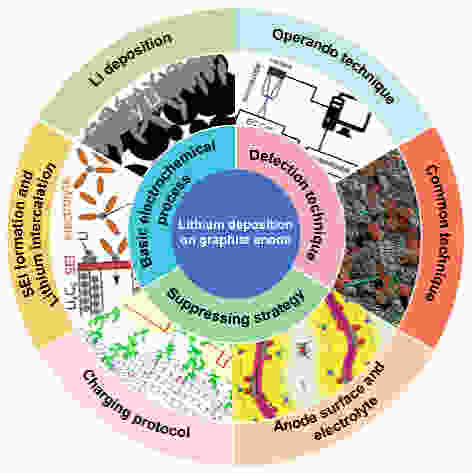
 下载:
下载:
